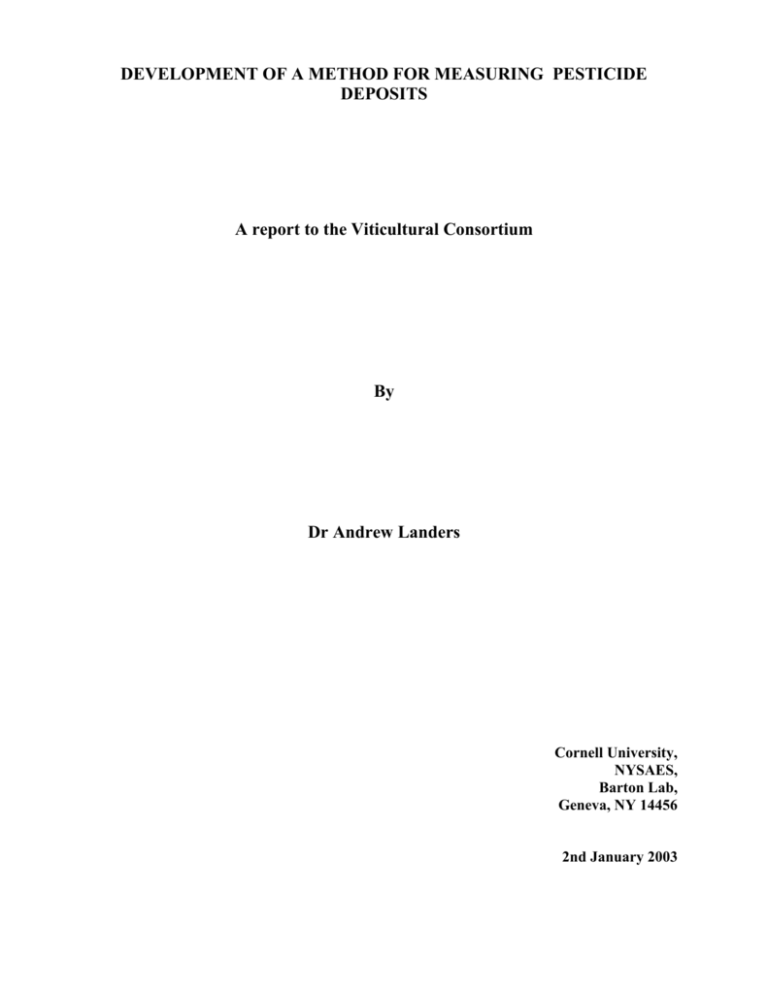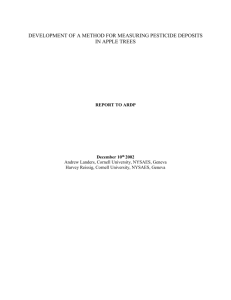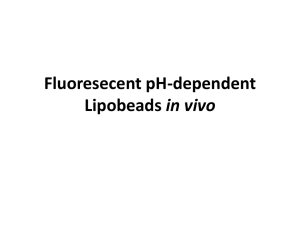Development of a Method for Measuring Pesticide Deposits
advertisement

DEVELOPMENT OF A METHOD FOR MEASURING PESTICIDE DEPOSITS A report to the Viticultural Consortium By Dr Andrew Landers Cornell University, NYSAES, Barton Lab, Geneva, NY 14456 2nd January 2003 Introduction How can researchers assess application equipment efficacy in vineyards? The leaves of a grape canopy tend to shingle and sometimes prevent droplet penetration into the centre of the canopy. How can we compare the effectiveness of novel direct deposition sprayers against traditional airblast designs? How much hits the target and how much drifts – deposition techniques can detect drift. Previous research projects undertaken by the above investigators at Cornell University have used a foliar application of Sequestrene, an iron tracer, unfortunately this technique has proved very expensive due to high laboratory charges. Water soluble cards have also been used to great effect but are very time consuming as far as placing and retrieving in the canopy and analysis. When studying the physical distribution of a spray deposit measurements can be taken from either natural or artificial targets. Artificial targets tend to be used for estimation of deposition because, however carefully you manipulate an artificial target, it can never truly represent natural surfaces so its collection efficiency may differ. For reasons of safety and economics tracer dyes are preferable over pesticides. Fluorescent tracers are often considered the best choice because quantification is fast, inexpensive and safe. Moreover sensitivity is extremely high, so often minute quantities of deposit, relevant in pesticide application, are detectable. One problem however is that like all dyes fluorescent compounds are subject to photo degradation, and adsorption so before a tracer dye can be used one must be fully aware of all of its properties. Objectives 1. To improve the standard of crop spraying and the understanding of safer pesticide application 2. To develop a method for measuring pesticide deposits using tracers 3. To evaluate the effectiveness of such deposition in the laboratory and vineyard 4. To assist farmers and growers in their selection of appropriate technology to reduce pesticide use and minimise environmental pollution via correct targeting of sprays. Table 1 A brief description of the different tracers available Tracer Type Tracer - Hot pink DayGlo – Blaze Orange Notes Quart in 100gallons 1 ounce/1 gallon, use with Kromacote cards, have two quarts. Very stable and soluble in water keep to a low pH however. Primary use is to colour foam-marking concentrates. They do create tracer dyes for pesticide applications ie. Blue for turf grass application. Jim.Reiss@precision.Labs 847 498 0800 ext.33 $18.23/quart 30 – 40% highly variable on requirements. Fluorescent colors need black light. EXP version is food safe. Rec. Dick Slawson Mira Debevc 1-800 4DAYGLO DayGlo Colour Corp, 4515 St Claire Ave, Cleveland Ohio – 44103 tel. 216 3917070. General info contact Robert Gonzalez DayGlo – Saturn Yellow DayGlo – Red Orange FD&C – Blue dye Fluorescent Dye Red Surround WP Bright Dyes rgonzalez@dayglo.com For Eco toxicological data contact Jeff Kosmetos jkosmetos@dayglo.com “ “ 1 – 2% dilution No.1 Granules no dilution instructions, it is a dye however. Rec. Brian in Soil lab 1 800 325 8110 Water-soluble used for water tracing and leak detection, each tablet dissolved in 60ga, to 1ppm. Red 5-7day degradation, yellow 2-3 days and blue 3-4 weeks. Formulabs Inc, Fluorescent dye tracing division 529 Forth Ave. PO box 1056, Escondido – CA 92025, Tel. 619 741 2345 No longer available Crop protectant, barrier film contains Kaolin, apply at rates from 50lbs/100-200 gallons. Dilute = quarter whilst concentrate = half and half. Engelhard Corporation 101 Wood avenue P.O.box 770, Iselin, NJ 08830 0770 1 pint to 9000 gallons, both visual and UV Yellow green colour Forestry Suppliers 1 601 354 3565 $36.95/ gallon Kingscote Chemicals 1 800 394 0678. Fluorescein water soluble Table 1 A brief description of the different tracers available (continued) Chemical Tracer - Hot pink DayGlo – Blaze Orange DayGlo – Saturn Yellow DayGlo – Red Orange Bright Dyes Fluorescein Surround WP FD&C – Blue dye Dilution as read Quart in 100gallons 1 ounce/1 gallon 30 – 40% highly variable on requirements 30 – 40% highly variable on requirements 30 – 40% highly variable on requirements 1 pint to 9000 gallons Converted 1g /100ml Cost $18.23/quart 35g /100ml $ ?/ gallon 35g /100ml $8 / lb 35g /100ml $8 / lb 12.5g /100ml $36.95 / gallon 25-50 lbs/100-200 gallons 12g /100ml $0.90/lb 1 – 2% dilution 2g /100ml $31.20 / lb Table 2 Solubility and costs of the available tracers Assessment of tracer dyes Fluorescein is the most widely used class of fluorescent dye, it is a water-soluble dye with bright yellow fluorescence. Because the fluorescence quantum yield for fluorescein (photons in/photons out) is near 0.9 in basic water, it is one of the brightest fluorescent dyes available. Of the other dyes available; hot pink and FD&C blue dye were non-fluorescent and so would not be as sensitive as fluorescein. Day-Glo colours and Furness yellow are not water-soluble and so could not be quantified via spectrometry. Measurement To measure the concentration of a dye in solution a spectrometer is required such as a fluorimeter. A wavelength scan is required to determine the exact adsorption and the emission maximum. Once this is known then the correct filters can be chosen. To do this a sample of tracer in solution is taken and placed in an absorption spectrometer where the wavelength is changed, and the absorbance and or emission measured. Below are the excitation and emission peaks for Fluorescein, showing narrow band widths, which signify intense colour. Creation of a reliable reproducible calibration line For successful fluorimetric analysis the tracer needs to be stable in solution (not form colloids or degrade during the measurement period). Known concentrations of the dye are taken and a calibration line created. This was achieved with an R2of 0.9976 yielding a straight and reliable reproducible (CV%3) calibration. Stability under black out: Adsorption tests It was necessary to find out if the tracer is stable as a dry deposit. Drops were applied via pipette (micro capillary pipette applying 10µl) and left in the dark for 1, 3 and 24hrs. The deposits were washed off with 0.05% NaOH and compared to the readings from 10µl applied to water and measured directly. In the dark all is well, no significant degradation was measured under blackout conditions so once samples are picked then they can be safely stored under blackout conditions. Leaf adsorption If there is leaf adsorption (adherence) then there will be an underestimation of deposit, a chemical is required which will not be adsorbed readily into the plant. Set quantities of tracer (10µl pipette) were applied to four different leaf varieties and directly to a glass beaker as a control and left for 2hrs. The leaves were also divided into upper (adaxial) and lower (abaxial) leaf surfaces to see if that caused any effect. Samples were left in the dark to avoid photo degradation, and then measured for fluorescent emission, the readings from the leaves were compared to direct pipette controls. Any difference would be assumed due to adsorption. There was no measurable adsorption to the leaf surface with any of the leaf surfaces (abaxial or adaxial). See Figure 3 in the appendix. Photo-degradation of Fluorescien in Solution As mentioned before photo-degradation is an issue with all dyes just to differing degrees, the level however, needs to be known if accurate measurements are to be taken. Small clear plastic cups were filled with 0.1, 0.01, 0.001 ml of stock solution per ml of distilled water to investigate the effect of concentration on degradation, and these were left for 0, 0.5, 1, 2, and 3hrs (5reps of each treatment). A regression coefficient was calculated form a calibration of the stock solution and the emission readings returned as concentration ml stock solution added. There was significant photo-degradation of the tracer. The photo-degradation was however, independent of concentration, in that it was proportionately the same for the three concentrations investigated. There was over the time measured (3hrs) on average 65% degradation. Photo-degredation on drying Fluorescent degradation was shown to be an issue but the only time however when samples are going to be exposed is between application and sampling. At all other times exposure can be controlled for example sample stored in black out conditions. The amount of degradation that occurs whilst the deposits dry needs to be calculated. Stock solution (0.01% fluorescein in distilled water) were applied to leaves using the 10µl pipette. The four different vine varieties were all tested to see if leaf type effected degradation. Leaves were placed out side and left to dry for an hour. One hour would be a worst-case scenario; samples are likely to dry in the field within an hour. Leaves were then washed in 0.05% NaOH and fluorescent reading compared to the controls. Results showed that there was approximately 55% photo degradation, with no significant difference between the different vine types. Conclusions. For field demonstrations the chemicals that are available are perfectly suitable, Saturn yellow at 30% concentration will provide a vivid deposit during daylight demonstrations and later under blackout conditions the deposits will be intense revealing all that the human eye can perceive. Surround is also vivid in daylight and the deposit will intensify under UV light in blackout conditions. The response for blackout demonstrations will not be as impressive as the Saturn yellow, but surround would cost much less. For detailed quantitative analysis of deposits the Bright dyes fluorescein formulation is capable of creating a reliable reproducible calibration line, and stable for extended periods of time in the dark. Once exposed to sunlight then severe degradation occurs, this does however occur consistently regardless of chemical concentration so will be relatively uniform in the field. Degradation can be simply calculated via the use of degradation standards. Prior to spraying leaves can be removed from the canopy and using the micro pipettes 10µl of stock solution deposited onto the leaves half the leaves will be exposed to the sunlight and half kept under blackout conditions. The likely degradation can then be measured and volumes from the samples adjusted accordingly. Degradation standards give a worse case scenario, so it must be realized that deposits found from the inner canopy are unlikely to have degraded as much. To calculate this a target some distance from the treatments can be used with standards placed above below and within the canopy giving a fair estimated of likely deposit degradation. It may however be prudent to purchase a different tracer with fewer photo-degradation issues thus negating the need for degradation standards. Fluorescent compounds to consider are Uvitex OB (soluble in isopropanol) or Brilliant sulfaflavine, which are much less sensitive to photodegradation. Acknowledgement I would like to acknowledge the technical assistance of Dr Jane Barber, my research assistant. Funding for this project was provided by the Viticultural Consortium-East, Lake Erie Regional Grape Program, Grape production research fund, New York wine growers, and the Wine and Grape foundation Detailed data may be obtained by contacting MaryLou Dumbleton Jordan Hall NYSAES Cornell University Geneva, NY 14456 Phone 315/787-2290; Fax 315 787-2276 Email mld2@cornell.edu







